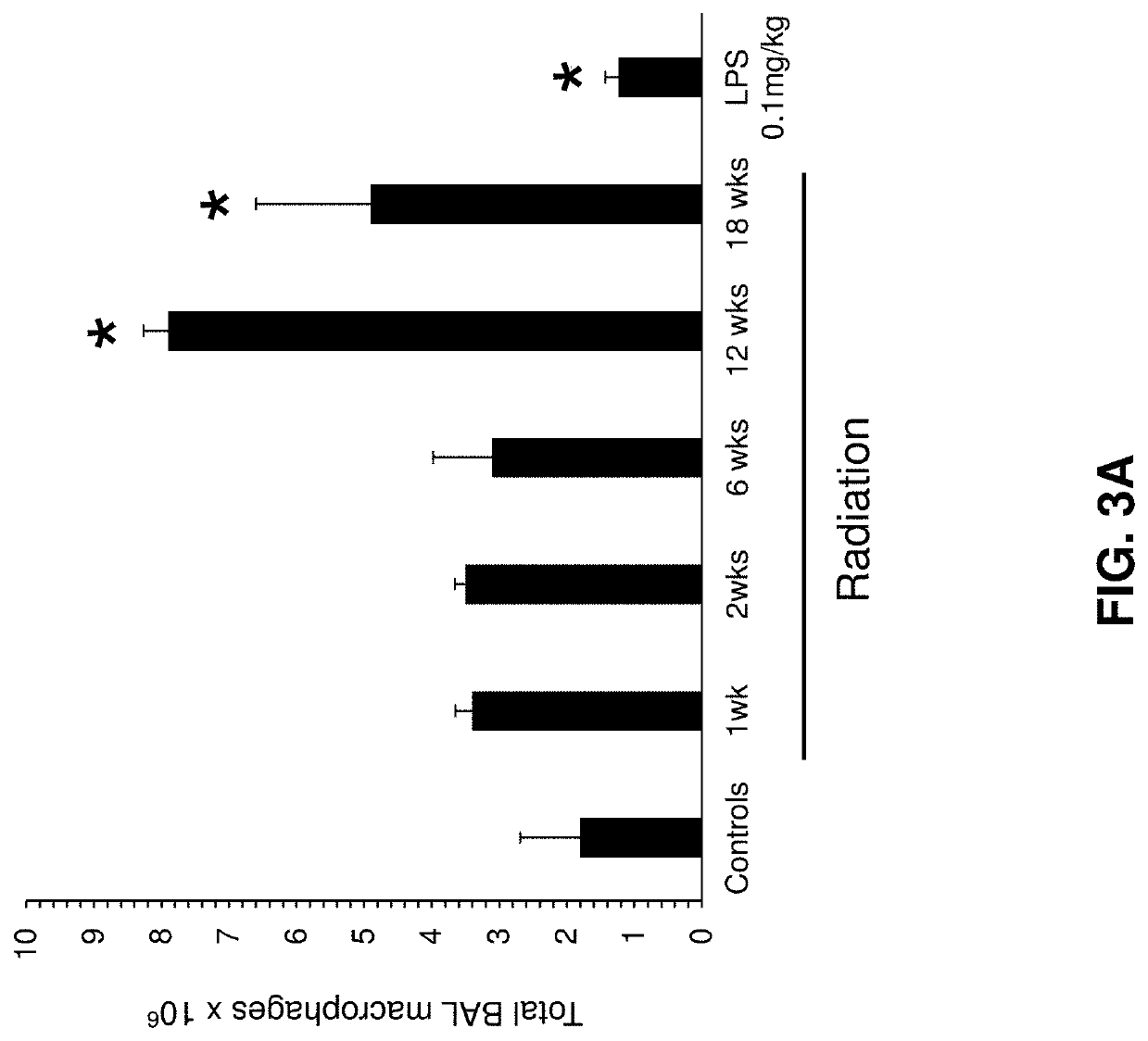Biomarkers and methods of use for radiation-induced lung injury
a biomarker and lung injury technology, applied in the direction of instruments, transferases, assay labels, etc., can solve the problems of limited options for rilf management, limited radiation dose use, and inability to validate therapies to limit rilf development or severity
- Summary
- Abstract
- Description
- Claims
- Application Information
AI Technical Summary
Benefits of technology
Problems solved by technology
Method used
Image
Examples
example 1
the Role of NAMPT in RILI
[0236]Given the important role for inflammatory cascades in RILI, the effects of radiation on expression of NAMPT, which is a TLR4 ligand and a damage-associated molecular pattern protein, was explored. Three groups of 057 / B6 mice were used to assess the role of NAMPT in RILI.
[0237]The first group consisted of wild type (WT) mice receiving a single dose of thoracic radiation (20 Gy). Mice treated with 0.1 mg / kg LPS served as positive control, while non-irradiated mice served as negative control (“Controls”). Lung tissues were harvested from the mice at specific times over an 18-week period. Amount of bronchioalveolar lavage (BAL) protein and cytokines was measured, cell counts / differentials were obtained, and NAMPT expression was assessed by RT-PCR in the lung tissues. Lung tissues were also subjected to hematoxylin and eosin (H&E) and NAMPT staining. Moreover, blood was collected from the mice to measure plasma NAMPT expression. Results from the correspondi...
example 2
Radiation on NAMPT Expression in Human Tissues and Blood
[0244]To further explore the role of NAMPT in RILI, the effects of radiation on expression of NAMPT in human tissues and blood was explored. The results are described in FIGS. 14A-14D.
[0245]To assess the effect of radiation on NAMPT expression, human tonsillar epithelial tissue was exposed to 8 Gy ionizing radiation (IR) for 24 hours. As described in FIG. 14A, NAMPT expression in human tonsillar tissues was rapidly and markedly upregulated after 8 Gy IR exposure. The effect of radiation on NAMPT expression was further assessed by studying NAMPT expression in cancer patients undergoing radiotherapy. As described in FIG. 14B, subjects undergoing radiotherapy for breast cancer (n=50) or lung cancer (n=34) exhibited significantly increased plasma level of NAMPT compared to control subjects (n=268) (p <0.0001). The effect of radiation on NAMPT expression was also assessed by studying NAMPT expression in patients with radiation pneum...
example 3
the Role of NAMPT in RILI Using an In Vivo Model of Radiation Pneumonitis
[0247]In order to further assess the role of NAMPT in RILI, WT 057 / B6 mice and NAMPT heterozygous mice (Nampt+ / −) were exposed to 20 Gy whole thorax lung irradiation (WTLI) and evaluated at specified time points over an 18-week period. The results are described in FIGS. 15A-15D and FIGS. 16A-16B.
[0248]As described in FIGS. 15A-15C, WTLI-exposed WT mice exhibited increased NAMPT expression, especially in alveolar macrophages and epithelial cells, and an increase in inflammation, vascular leakage and inflammatory lung injury 4 weeks (FIG. 15A), 12 weeks (FIG. 15B) and 18 weeks (FIG. 15C) after 20 Gy WTLI compared to sham-exposed mice (non-irradiated mice; shown in inset). FIG. 15D summarizes NAMPT staining in lung tissues 4 weeks, 12 weeks and 18 weeks after IR exposure; sham-exposed mice (non-irradiated mice) served as negative control. On the other hand, NAMPT heterozygous mice (Nampt+ / −) showed reduced inflamm...
PUM
| Property | Measurement | Unit |
|---|---|---|
| Nucleic acid sequence | aaaaa | aaaaa |
| Level | aaaaa | aaaaa |
Abstract
Description
Claims
Application Information
 Login to View More
Login to View More - R&D
- Intellectual Property
- Life Sciences
- Materials
- Tech Scout
- Unparalleled Data Quality
- Higher Quality Content
- 60% Fewer Hallucinations
Browse by: Latest US Patents, China's latest patents, Technical Efficacy Thesaurus, Application Domain, Technology Topic, Popular Technical Reports.
© 2025 PatSnap. All rights reserved.Legal|Privacy policy|Modern Slavery Act Transparency Statement|Sitemap|About US| Contact US: help@patsnap.com



